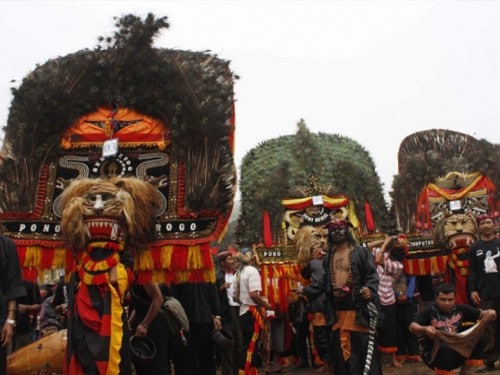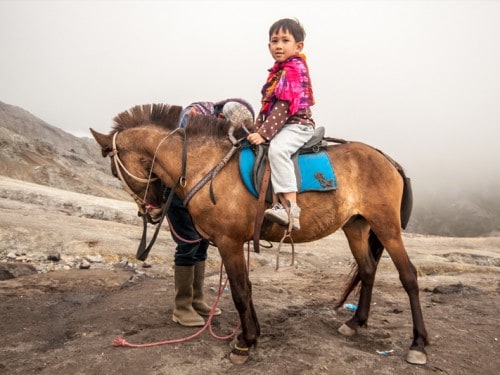Standing majestically in the huge caldera of the once ancient Mount Tengger, is Mount Bromo, The icon of East Java, a truly magnificent wonder. Its spectacular sunrise and stunning picturesque scenery have captivated tourists from all around the globe. Mount Bromo is also the home of the Tengger sub-ethnic group who until today still preserve their age-old traditions and way of life. One of these is the art of Reog. Although Reog itself originates from the neighboring regency of Ponorogo, the Reog Tengger has its own distinct characteristics that distinguishes it from Reog Ponorogo.

Photo source : www.goodnewsfromindonesia.id
Reog is a traditional Javanese dance from East Java that involves many elements including graceful choreography, extraordinary physical strength, as well as extravagant costumes and decorations.
The main character of Reog is the magical lion-like creature called Singa Barong. Singa Barong is a huge mask made to resemble a tiger's or leopard's head, over whose head are fans of long peacock feathers. The Singa Barong mask is notoriously heavy where the dancer must be capable of carrying the 30 to 40 kg mask by the strength of his teeth only. For this reason people believe that the person able to execute this feat must surely possess supernatural abilities and strength.

Photo source : www.ryphua.blogspot.co.id
Sometimes, the Singa Barongan - sometimes called barongan - may also carry a young man or girl on the lion's head. In addition to the weight of the person sitting on top of the lion's head, therefore, the Reog dancer must then carry a weight of around 100 kilograms , and this only by the strength of his teeth! . Holding this huge heavy mask by biting into it, he relies on the strength of his jaws, neck and shoulder muscles. The width of the mask itself spans more than 2.5 meters including the peacock feathers and other colorful decorations.

Photo source : www.travel.radarmalang.id
A Reog performance usually consists of three sets of dances while each dance is performed by several persons. The first is the opening dance, performed by warok, male dancers wearing completely black costumes symboliseing rough men wearing intimidating moustache and other masculine attributes.The second is the Jaran Kepang dance performed by Jatil which was originally performed by a gemblak, a handsome, teenage boy wearing colorful costume. Today female dancers usually play this role. While the third dance is the main attraction of the show performed together by all Reog dancers. The warok as the star male performer, carries the large and heavy lion mask and dances on center stage while the others dance around him. To emphasize the barongan dancer's extraordinary strength, the Jatil then climbs on top, riding the lion mask and is then thus taken around the arena.
Origins and meaning of Reog Tengger
The Reog dance portrays the story of Klono Sewandono, king of Ponorogo who journeyed to Kediri to seek the hand of Princess Songgo Langit. On this journey, the King along with his entourage and soldiers were attacked by a vicious monster called Singa Barong, a mythical lion with peacock feathers on its head. A great battle ensued which involved not only in physical fights but also using supernatural prowess.
The performance is then accompanied by vibrant music of the traditional gamelan orchestra that comprise the gendang, gong, saron, kenong, angklung, and other traditional instruments. However, distinct from the original Reog Ponorogo, Reog Tengger also incorporates modern musical instruments such as the electric guitar and bass. These are innovations made by the Tenggerese, that not only include traditional songs but also the more modern 'campur sari' tumes that are very popular among the Tengger communities.

Another different aspect of Reog Tengger when compared to Reog Ponorogo is that while Reog Ponorgo relies mostly on exceptional physical strength that has been developed over years of intensive training, the Reog Tengger adds more mystical elements where the barongan's dancer is brought into a trance when he performs the dance. To achieve this, special preparations are needed before each performance: A 'dukun' or 'shaman' prepares offerings to bless the performance and to attract 'spirits' to join in the performance. The offerings include gedang ayu, rokok kinangan komplet (hand-rolled cigarette consisting of areca nut, betel, and a combination of three flowers known as KembangTelon), Jenang Wonco (traditional Javanese snacks cooked in five colors: white, red, green, yellow, and black), Sego Gulung (7 rice balls with steamed egg filling), black coffee (without sugar), fresh water, kembang setaman (various types of flowers), pituan (Coconut, rice, and 5 raw eggs), and more.
When you travel to Bromo in East Java take time to witness this extraordinary performance!
Photo source of header banner : www.en.brilio.net
















